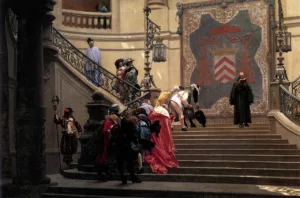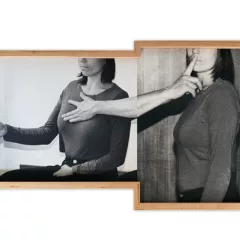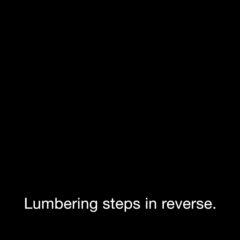Art critic Jerry Saltz and art dealer Jeffrey Deitch came to the Wharton School Wednesday to talk about the art biz. The talk was a collaboration between the Institute of Contemporary Art and Wharton.
ICA Director Claudia Gould did the intros to a spillover crowd in Wharton’s Huntsman Hall. An unusual number of the attendees were dressed in suits! I also spotted a couple of big-time collectors, gallery people, artists and art students in the mix.
Gould said Saltz, the critic for New York Magazine, took a no-nonesense approach to discussing art. Deitch, she said, was a Harvard MBA, who at one point ran an art-advisory service for Citybank. In 1996 he founded his gallery, Deitch Projects, which represents a wide range of artists from Jeff Koons to Swoon to Nari Ward.
Here’s how the talk went…more or less.
The Art Industry
Deitch: …the 1970s, it’s an exaggeration to call it a market. In the ’80s, there was a real market. But now it’s something beyond, beyond. It’s the Art Industry. We are in an art market boom.
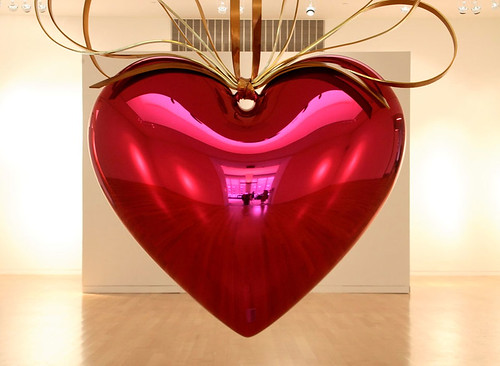
Jeff Koons’ spectacular Hanging Heart (Magenta and Gold), 1994-2006. © Sotheby’s Images.
I spent most of the 1990s on Jeff Koons’ Celebration Series. Hanging Heart was part of that series. It, the Celebration Series was too expensive to make–it was $2 million to make Hanging Heart. Sotheby’s gave it an $18 million guarantee. It sold for $24 million. There were 5 bidders, including new collectors from Kiev.
It’s most interesting, the position of art in our economy. Art culture was invented in Soho as art and attitude. It became an amazing economic engine, spreading around the world, starting with what artists do with no money. [i.e. a bunch of artists get together and start a gallery with no money].
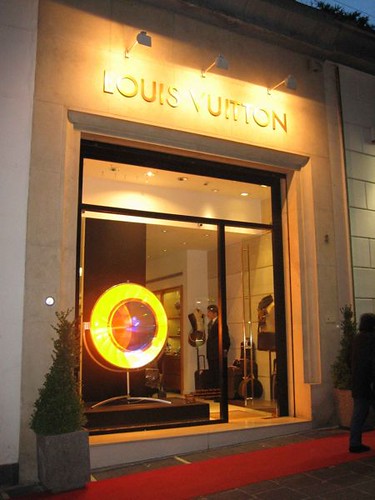
Olafur Eliasson’s “Eye See You!” a multiple made of mirror, glass & light sculpture, in a Louis Vuitton window in Naples, one of 350 Vuitton boutiques sporting the art for Christmas 2006 (Ph. Katia De Angelis)
[Deitch cited some examples of the resulting art industry climate–Olafur Eliasson in the Louis Vuitton window, making it acceptable for other artists to put their work in commercial windows, something that previously would have been considered selling out; also Mariko Mori and Barry McGee doing work for Prada; and even what seems like the beginning of it all, Keith Herring on Absolut Vodka ads.]
There’s UBS sponsoring the Art Basel Fair, and its involvement with the Tate Modern. It’s something we’re going to see more of.
Artists are becoming entertainers and collaborating with entertainers.
The Art Product
Damien Hirst created the brand of Damien Hirst. For example, the restaurant The Pharmacy in England, Hirst did the fixtures. When the restaurant closed, the fixtures went to auction and sold for $20 million!
Art Spectacle

Tim Noble and Sue Webster’s Electric Fountain, to open at Rockefeller Center Feb. 27. LED-generated light sculpture, 35 feet high and 30 feet in diameter, timed to replicate the movement of water. (This is sponsored by Lexus).
There’s Jeff Koons’ Puppy, Olafur Eliasson’s Weather Project at the Tate Modern, at Rockefeller Center, Tim Noble and Sue Webster’s Electric Fountain.

Guggenheim Abu Dhabi, image from World Architecture News.com
Then there’s the Bilbao effect–the development of the image of a country with the Guggenheim Abu Dhabi.
Saltz: Jeffrey’s showing how the engine works. Me, I’m showing what happens when the engine works well. (As I Jew I can’t go to Abu Dhabi. I’m Jewish. I’ve been to Israel. Gehry is Jewish. Guggenheim is Jewish. they’re taking the -heim out of Guggen-, if you know what I mean.)
Money and art have been sleeping together since the cave.
Hubris
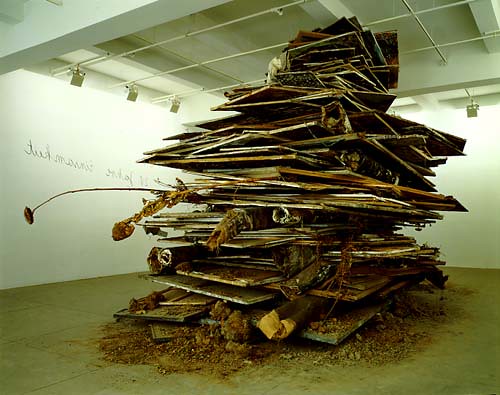
Anselm Kiefer, 20 Jahre Einsamkeit 1971-91, at Marian Goodman Gallery, 1993
May 1, 1993, [after Anselm Kiefer’s show at Marian Goodman, described here by Peter Schjeldahl]–there was a party that night at Industria. The floor was covered with white sand. Everything was white. the creme de la creme of the art world was there. If a bomb had dropped on this, that’s it. Pffft, the art world.
The dinner was thymus glad, blood soup, and testicles of small animals. The final touch, Pig tartare. (I’m Jewish. This is not kosher).
[Saltz says the dinner and a number of other things, like very large paintings by Julian Schnabel, and Mary Boone’s new gallery are hubris.]
Her new office, with Julian Schnabel on the wall–she no longer represents him–is corporate. It’s as cold as ice…
[He shows a picture of the Jeff Koons wooden sculpture of the artist and his ex-wife having sex, then then he flashes a series of Jeff Koons’ pornographic paintings on the wall, from the exhibit at Castelli the same year as the Kiefer show.]
Every single day, the gallery was packed. The sculpture, however, was emitting an enzyme that was preventing anyone from looking at it. The show was basic male het porn.
After that show, Jeffrey was never in another biennial or Documenta. In 1993, the art world embraced Mapplethorpe and ejected Koons. Then he built the puppy, but he didn’t have a gallery show for 10 years.
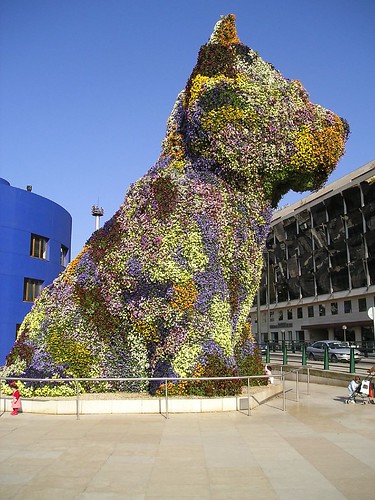
Koons Puppy at Bilbao downloaded from http://blog.bjork.com/2007/07/12/the-puppy-in-bilbao/
Art is so expensive… museums can’t buy it any longer. That means the art will never be seen in public again. Works in museums should never be sold into private collections.
Art fairs–these are traveling tent casinos. I love them. Artists are making money in them.
[But it’s impossible for artists to produce enough product for the art fairs.] How many pieces of good art can you make in a year. Could Goya make that much great art?
[to Deitch]: Did I say anything to offend you?
Deitch: I think you didn’t go far enough. People all over the world know the name of Jeff Koons. We’ve gotten everything we wanted, in a way. Business is enveloping the art enterprise, even in danger of smothering it. Very good artists have turned their studios into production factories.
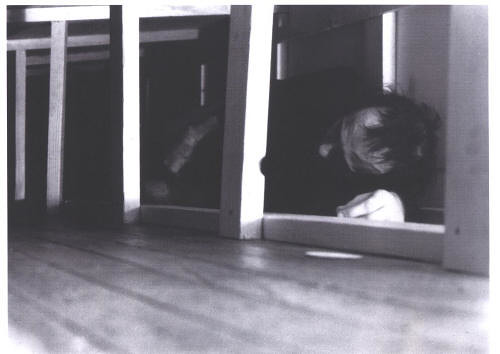
Vito Acconci, lying under the floor in Seedbed, 1972.
Saltz: 99.999 percent of artists are not making money. What happens to someone like Vito Acconci or Eleanor Anton? If they don’t sell, does it mean they’re bad?
Deitch: Museums are in a straight jacket. You cannot go to MoMA and see art from the 80s to the present. The only place where you can get a clear view of art from 1950 to the present, it’s only at Christie’s and Sotheby’s [Christie’s sponsored the talk]. Collectors, this is where they learned. The auction houses have rooms for each decade, and in each room, only 10 artists are allowed in. For the 1980s only 10 artists are allowed in. If you’re not in the top 10, you don’t exist.
I went to see the Eli Broad collection. You only see artists from these top 10 lists.
Saltz: In the art world, chaos is a friend. The market is a force of chaos. It’s a mistake to look at the market in a purely negative way. The market is like a camera. It’s so dumb, it’s a self-replicating organism. As soon as someone buys something, other buyers follow.
Deitch: In the ’70s, there were six galleries in Soho. In those six galleries, you could see the whole world of art, and it was all in New York. Now in New York, there are 500 serious galleries and thriving scenes in other cities. It is impossible to see it all now.
The auction rooms by decades, or the art fairs with 150 galleries–that’s how the market deals with chaos.
Audiences need aesthetic leadership. They find it in auctions, and in international galleries. The international galleries are the same as brand names. There’s a Russian collector, he only buys from White Cube and Gagosian.
Saltz: Art is not fair. When we’re down to fewer brands, it becomes like a two-party system. We can’t relinquish leadership to the powers that be. Biennials seem to be mirror images of each other. The ICA does original stuff. But it’s not a collection. There’s no contemporary art permanently on view at a museum.
There is in London.
If you only see the mountaintops, you will never know how tall they are.
When you sell out a booth in an hour at an art fair, what happens?
Deitch: This year we brought 100 works, so we kept restocking as things sold. In past years, we sold out in the first half hour. But Saturday, Sunday this year, it’s as if it’s the boat show or the home show. Who are these people just peeling off $150,000 to $250,000 to buy a work of art? Basically, they’re American entrepreneurs–85 percent American.
How to start a gallary
Saltz: To start a gallery, you’d have to max out three or four credit cards plus $20,000 to start a gallery.
Deitch: You’d need tens of millions–or something really remarkable, someone who comes out of nowhere, who opens a store front. The word spreads.
Art galleries are built out of nothing. Someone who has the vision can start with basically nothing and build a great gallery.
On the other hand, if a gallery with a point of view shows a great artist, they’re damned, because that’s when Gagosian will send a private plane and that artist will be gone. A lot of people do it out of love, and its not a real business. We all like the variety. As the art business gets bigger, I’m not sure this model can last.
Some galleries are very high pressure, like White Cube. Mary Boone yells at people like her children. Business tycoons come in and they like it. It’s effective.
I like to connect with a few people [collectors] who really get it. Art collecting is a form of making art–a vision. It becomes a stimulating dialogue. A dealer learns from them. You’re helping people build a vision. I prefer when it’s like a relationship, where you meet a friend.
At this point, the two speakers took questions from the audience:
How has the recession affected young artists?
Deitch: Art can’t be immune from a recessionary environment. Something new has happened. When I began in the business, collectors were not super wealthy. So now there’s a phenomenon, with people with $10 billion plus, and with rabid collectors of art who go to collect the young people right out of Columbia.
There’s a new phenomenon where the artists and the galleries prefer selling to where the work is presented rather than selling to prestigious museums where the art might not see the light of day for a number of years.
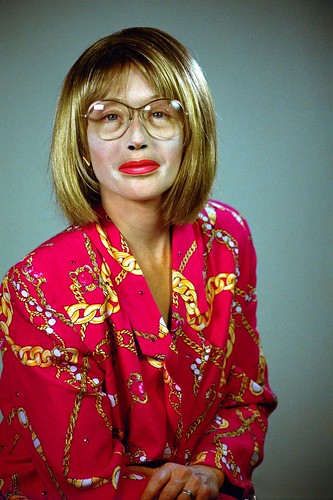
Saltz: The percentage of great artists never really goes up or down. There are lots of bad artists. Very few artists survive from the ’80s. Cindy Sherman does.
Now there’s a whole lot more art being made, and a lot more bad art being made. If 90 percent of shows all agree are bad, why are 90 percent of the reviews good?
So the 10 best per decade is right? [The artists in the audience seemed to be especially worried by the 10 best idea.]
Saltz: No.
What are everyone’s motives and strategies at art fairs?
Deitch: There’s a whole new layer of buyers–people who are in the business of collecting–who want what’s hot and rush to get it. Our nemesis pretends to be a real collector. Within a year or two, the whole thing ends up at Sotheby’s.
Artists are trusting me to place their work in a place where it has a context. I find myself playing defense so I don’t sell a prime piece to one of these collectors.
How is the business situation affecting the work being made?
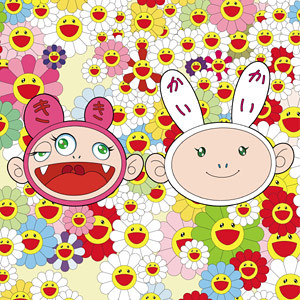
Takashi Murakami, Kaikaikik News (image from http://www.bbc.co.uk/dna/collective/A875171)
Saltz: Murakami, he’s playing into it. It doesn’t look like a human being made it. Hirst’s realistic paintings–He’s making something Prada, he’s making placeholders for the rich. Is that gaming the system or are you gaming yourself?
Freud said we all want three things: sex, money and immortality. At the end of the day, you have to be in it for the credibility. You can’t buy that.
The top 10 in the auction house decade rooms, how did they get there?
Deitch: My job is to get an artist into that top 10. It’s about building a consensus. You need people like Jerry involved, glamorous people involved, a fashion connection, a collector there early. That is my function.
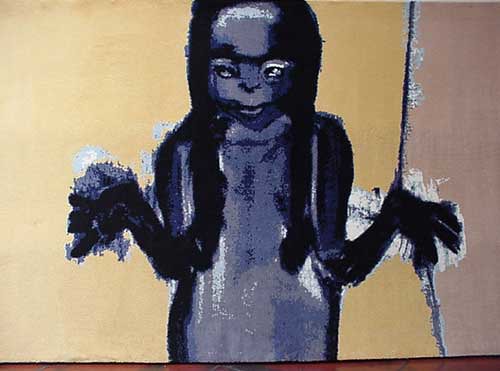
Marlene Dumas, The Benefit of the Doubt, 1998, Tapestry from http://www.artthrob.co.za/07dec/archive.html
Saltz: Are we liking what we like because we hear that other people like it? [He wonders if that’s why people like Marlene Dumas.]
Gould: Why are you so hard on Marlene Dumas? You need to come clean.
Saltz: I’m also down on Richard Prince and Murakami. Dumas is not stylistically original. It’s the subject matter people like in her work–dead babies…
I’m really not looking at what you make. All crucifixions are the same.
[tells of seeing a Fragonard at the Getty and suddenly recognizing he’s a genius. Also tells about seeing a Tiepolo and getting it, after 30 years of no connection to it.] This is what I love about art…and Boom, Fragonard is a genius. Dumas, now I’m stuck in print not liking her work.
Ileana Sonnabend said, I want what I don’t like. What does that mean?
Deitch: The strongest art challenges you, is difficult. Art that’s pretty and easily read rarely has staying power.
Saltz: Art is a language beyond words. Yet we must talk about it.
Deitch: The best art, it changes the structure of art. It doesn’t come easy. [He mentions Rauschenberg and Gilbert & George as examples.]
Saltz: Great art is new units of thought. It changes the molecule.
Deitch: Christie’s sale of the Donald Judd estate was a great show. Roberta Smith reviewed it as if it were a museum show. It sold at 20 percent more than if it just sold at a gallery. I heard a rumor that Damien Hirst will cut out the gallery. It’s going to be auctioned directly. Artists without any support, Banksy …rented a warehouse and made $2 million to $3 million.
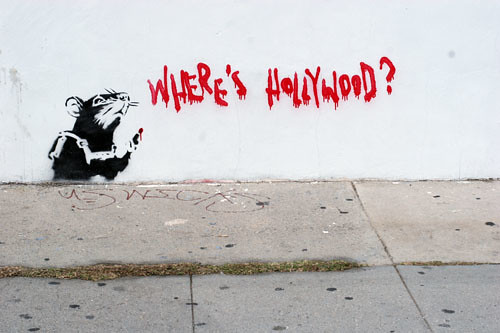
Banksy in Hollywood, downloaded from http://www.woostercollective.com/2006/02/bansky_goes_hollywood.html
Is Banksy a hypocrite?
Saltz: Is Banksy a hypocrite because he makes $2 million?
How does a young collector begin?
Saltz: Don’t worry if the work will pan out as good or bad. Buy what you love. I write about stinky artists who I love.
Deitch: Go around to galleries, find a dealer on the ground floor who has a vision and who really gets it.
Saltz: Nobody knows what art is. It’s a hyper sponge. You can put anything into it and it will process it. It’s not just those 10 (top artists per decade). If you keep working, you will be successful, by my definition of success, and take the time to make something of your stupid art.
Deitch: Art is sustained and reinterpreted through succeeding generations. This is how art builds the art historical pantheon.


